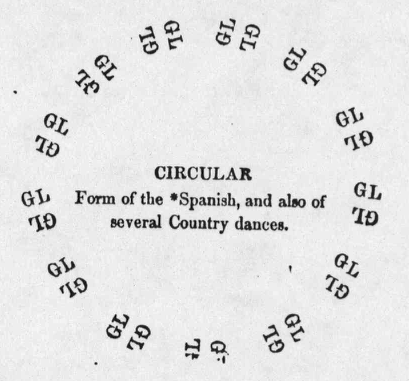
It can also be danced in double lines rather than a double circle, but this gets messy at the ends, so a circle is generally preferable, if there's room for it.
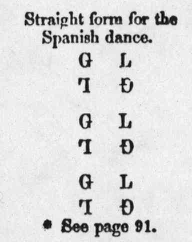
Form a circle of couples as illustrated below, every other couple facing along and against line of dance, forming sets of two couples facing each other, as in the Sicilian Circle.

It can also be danced in double lines rather than a double circle, but this gets messy at the ends, so a circle is generally preferable, if there's room for it.

2 bars: Taking inside hands with partner (his right, her left), balance forward and back.
2 bars: Taking inside hands with opposite (his right, her left), turn* into new position with Lead progressing 1/4 around the set to his left, Follow progressing 1/4 around the set to her right, into each other's places. But now, instead of facing along and against line, you're facing into and out of the circle, with your opposite at your side, instead of your partner.
* How shall we interpret the direction to turn? A popular interpretation these days has the Lead give the opposite Follow an outside underarm turn, with the Follow walking forward under the connected arms before falling back to the right side of the Lead. This is a fun and dynamic option - and a personal favorite of mine - but I've yet to see it described that way in a 19th century source.
In the context of 19th century set dances, to "turn" usually means to take hands and walk around each other, and that's almost certainly what is meant in these descriptions as well: to take her left hand in his right, and rotate clockwise as a couple to fall back into place, him a quarter turn, her three quarters.
That being said, the underarm turn version of the dance is a perfectly good one, and it's the one I usually teach when I teach this dance, because a) it's the one many dancers already know and love, and b) it's more fun. Given how much variety and ambiguity exists in the original sources, it's more than fair to add a bit of creative interpretation every once in a while (as long as you acknowledge that that's what you're doing). This is a great example of that.
12 bars: Repeat the first four bars three more times (for a total of four times), to return to original place with original partner. You'll advance toward and turn your opposite, then your partner, then your opposite, then your partner, moving 1/4 around the set each time.
4 bars: Follows take right hands, Leads take right hands above them, and all star clockwise around the set.
4 bars: Follows take left hands, Leads take left hands above them, and all star counter-clockwise around the set.
8 bars: Waltz* once and a half around opposites and continue on to meet the next couple approaching from the other direction (couple 1 now dances with couple 4, couple 3 with couple 6, etc.).
* Several options:
There are other variations of the dance that can be explored below, but the description above represents the majority variation.
Any square (4x8) waltz. Many groups do it quite fast, but I prefer it at the slower end of the rotary waltz range to keep the balances and turns comfortable and sociable.
Huestis 1841 suggests Cinderella Waltz, Kate Kearney, or the Cachuca.
Andrews 1850 provides this music:
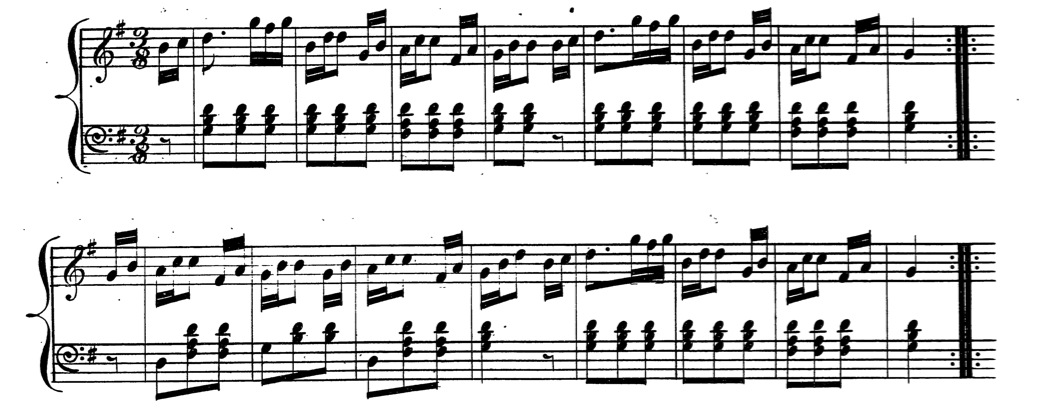
Howe 1859 provides this music:
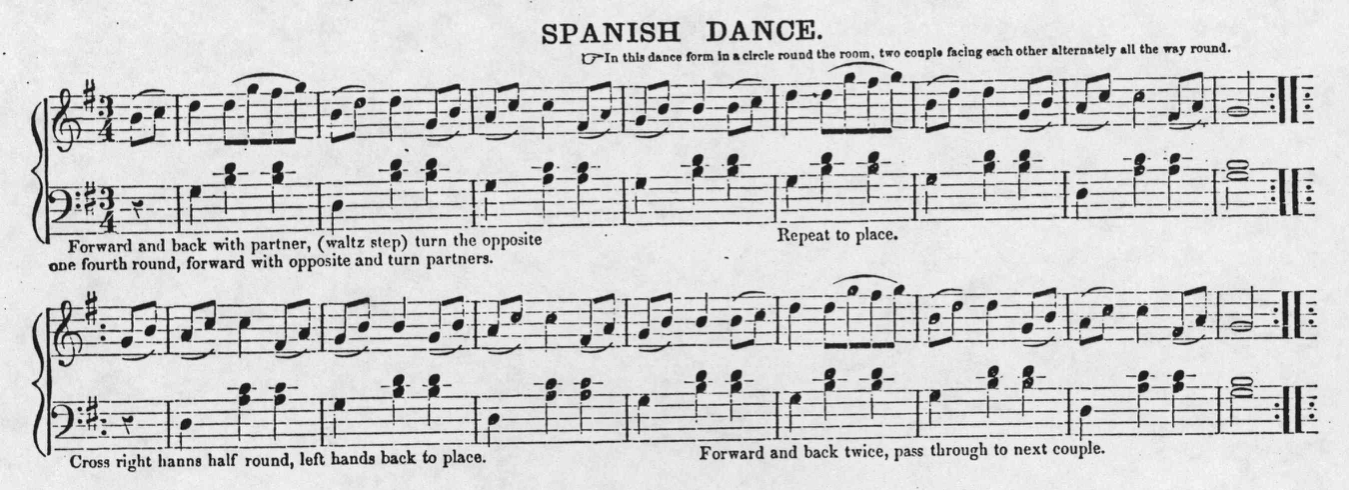
A medley of 19th century Spanish Dance music can be found on Spare Parts' Civil War Ballroom album.
In the spirit of creative interpretation, here are some 21st century variations that can be added to the Spanish Dance, most of which I learned from Joan Walton:
Turn Variations
© 2015 Nick Enge
(Click to expand)
Spanish Dance (Huestis, 1841):
This can be danced by any number of persons. The couples take their position on the floor in the following manner: first couple at one end of the room, back to the wall-the next couple directly before, and face the first-third couple next to the second, and face the same way as the first-fourth couple next, and the rest in the same manner, till the column is completed, which may go the whole length, or completely round the room, according to the number present. If all have taken their positions right, the couples will be in the following order: first and second couples face each other-and third and fourth, fifth and sixth, and all others in the same manner.
The music for this figure must be a waltz, or tune in triple time, as Cinderella waltz, Kate Kearney—the Cachuca and others. It commences with
BALANCE—Gentlemen and partners take hands; first and second couples balance forward to each other and back, balance again, and gentlemen exchange partners-first and second gentlemen taking the left hands of the opposite ladies and turn partly round, so that the couples may face each other, but across instead of lengthwise of the columns; balance again, back, forward, and both gentlemen take the left hands of the opposite ladies, (their partners,) and turn so that they may again balance lengthwise of the room, but both couples have exchanged places; the balance is performed four times, by which means each couple will have occupied and balanced from four different positions.
CROSS HANDS—The two ladies take right hands, and gentlemen take hands across them, forming a star; the four half round, change hands, face the other way, and back to places. Partners take hands and promenade to the right, in a circle, the first couple passing the second, and stop facing the third, next below, with whom they balance, &c. This completes the description of the figure, as after the promenade the couples balance to those before them as at first. Every two couples in the column balance at the same time. After every balance and promenade, by passing those with whom they previously balances, the gentlemen and partners will find themselves facing a different couples; so that a lady and gentleman commencing at one end of the room, may go to the other by the time the music ceases; which in this dance depends entirely on how long the company may choose to keep the floor.
Spanish Dance (Coulon, 1844):
The couples are arranged as for a country dance; the lady and gentleman at top changing places previous to commencement of figure; they then set with second couple, crossing into their places, set to partners, cross over again to second couple, and then to partners; all join hands, advance, retire, and turn round, four times repeated; concluding with poussette.—Danced to waltz music; and sixteen or twenty couples may take part in it in a circle or line.
Spanish Dance (Cellarius, 1847, Drawing-Room Dances):
The Spanish dance can be danced by any number of couples, which are arranged in two lines, the ladies on the left, the gentlemen on the right. Before beginning, the first couple change sides. The step and the music is the same as in the waltze. The figure is composed of three parts. The first couple advance, return and change places with second couple four times (sixteen bars).
The first and second couple join hands, advance, return and turn to next place four times (sixteen bars.)
The two couples waltze round each other twice; the first couple changing places with the second so as to be ready to go on with the dance with the third (sixteen bars).
Spanish Dance (Hazard, 1849):
[Verbatim copy of Coulon, 1844]
Spanish Dance (Andrews, 1850):
A dance in 3-4 time, it is composed of 6 changes, dance in waltz time. A gentleman with his partner takes the forward and back step and turns the opposite lady, this makes one change, he forwards again turning the opposite lady, and so on until he turns his partner. Balance to partner, Waltz or Promenade.

Spanish Dance (Kent & Co., 1850):
[Verbatim copy of Coulon, 1844]
Spanish Dance (Howe, 1859):


In this dance form in a circle round the room, two couple facing each other alternately all the way round.

Forward and back with partner, (waltz step) turn the opposite one fourth round, forward with opposite and turn partners [8 bars].
Repeat to place [8 bars].
Cross right hanns [sic] half round, lefts hands back to place [8 bars].
Forward and back twice, pass through to next couple [8 bars].
The Spanish Dance (Bland, c. 1868):
The couples stand as for a Country Dance, except that the first gentleman must stand on the ladies' side, and the first lady on the gentleman's side.
First gentleman and second lady balancez to each other, while the first lady and second gentleman do the same, and change places.
First gentleman and partner balancez, while second gentleman and partner do the same, and change places.
First gentleman and second lady balancez, while first lady and second gentleman do the same, and change places.
First gentleman and second lady balancez to partners, and changes places with them.
All four join hands in the centre, and then change places, in the same order as the foregoing figure, four times.
All four pousette, leaving the second lady and gentleman at the top, the same as in a Country Dance.
The first lady and gentleman then go through the same figure with the third lady and gentleman, and so proceed to the end of the dance.
The Spanish Dance (Routledge, c. 1868):
This pretty though now somewhat old-fashioned dance was, before the introduction of the Deux Temps and Polka, a principal feature in every ball-room. It is danced with the step and music of the Old Valse à Trois Temps, played slower than the music of the Deux Temps.
Sometimes the couples stand in two long parallel lines, as in a country dance ; sometimes they are arranged in a circle. The leading gentleman must be on the ladies' side, and his partner on the gentlemen's side. Every fourth lady and gentleman exchange places, to avoid the necessity of keeping the other couples waiting. The whole set can thus begin at the same moment.
Leading gentlemen and second lady advance and retreat with valse step, and change places. Leading lady and second gentleman do the same at the same time.
Leading gentleman and his partner advance and retreat, and change places. Second lady and gentleman do the same at same time. Leading gentleman and second lady repeat this figure; first lady and second gentleman likewise, at same time.
Leading gentleman and first lady repeat same figure; second gentleman and lady repeat at same time.
All four, joining hands, advance to centre, and retreat. Ladies pass to the left. Repeat three times. Each gentleman takes his partner, and the two couples valse round each other once or twice at pleasure; the second lady and gentleman being left at the top of the figure, as in a country dance. Leading gentleman and partner repeat same figure with succeeding couple to end of dance.
It is obvious that there must be an equal number of couples; and that they must be arranged in sets of four, eight, sixteen, twenty, twenty-four, and so on.
The Spanish Dance (Cartier & Baron, 1879):
Call As Follows:
Two Couples:
Forward Four.
Change Partners.
Forward Four.
Change Partners.
Repeat.
Cross Right Hands.
Cross Left Hands.
All:
Waltz.
These movements are performed by the new set, and go on until the music ceases.
Spanish Dance (Schell, 1890):
Waltz time. Form as for Sicilian Circle.
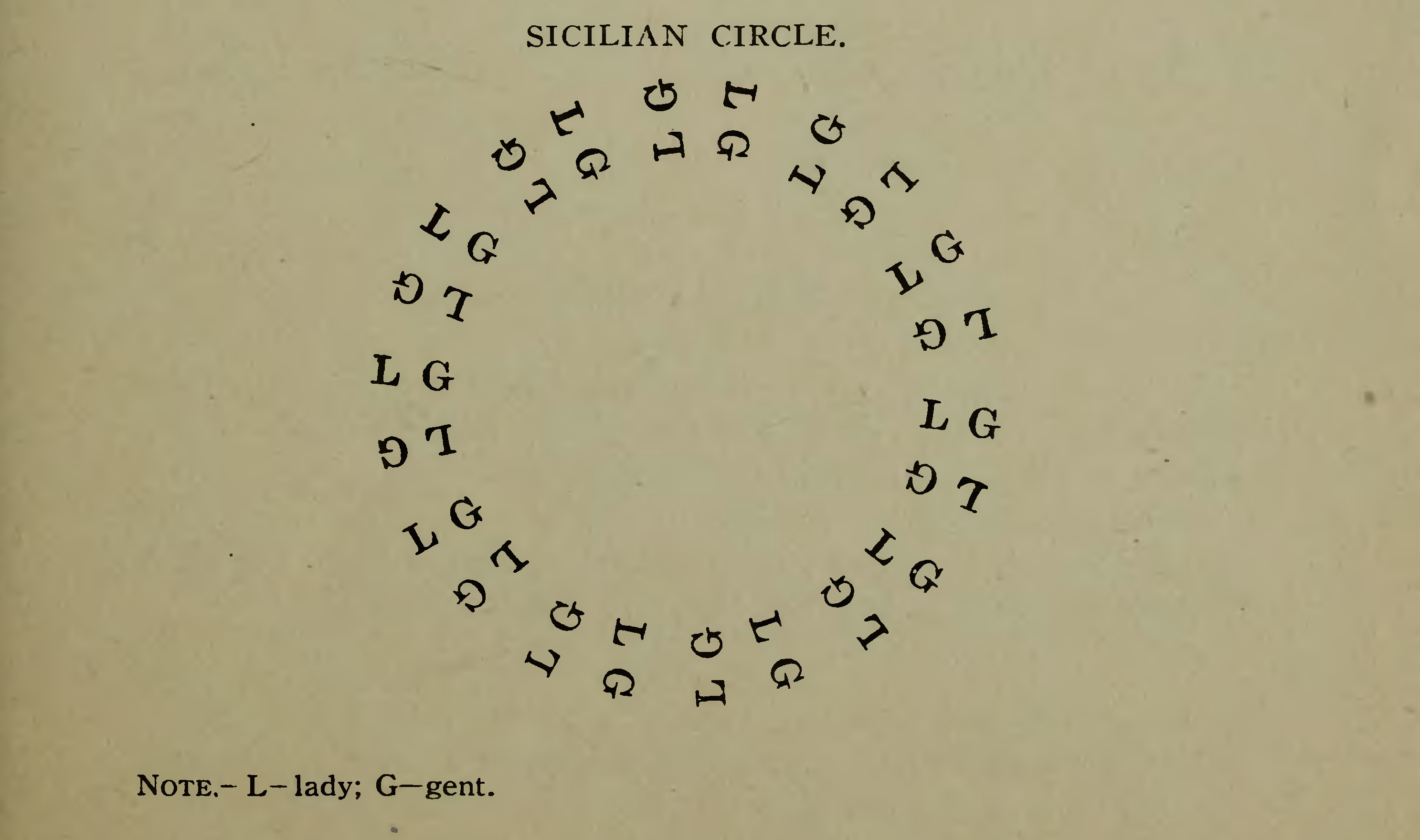
Forward and back with partner (4); turn the opposite (4); forward and back with opposite (4); turn partner (4); cross right hand half round (4); left hand back (4); forward and back (4); forward, and pass by to next couple.
The Spanish Dance (Wilson, 1899):
This dance can be performed by any number of couples, arranged in a circle as in the following diagram:
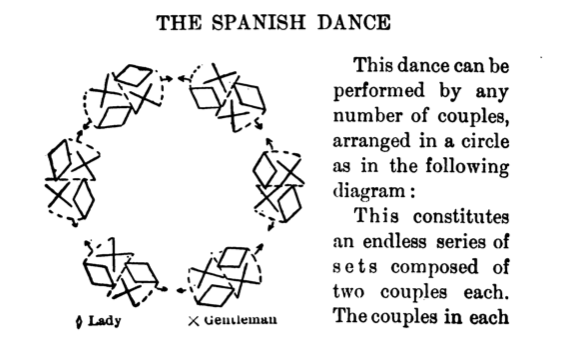
This constitutes an endless series of sets composed of two couples each. The couples in each set face each other, and have their backs towards the couples in the adjoining sets. Each set may be regarded as a little square, the ends of which are occupied by the two couples, while the sides are vacant. The music is in waltz time, with three beats in a measure, the first beat only being accented.
DESCRIPTION OF THE DANCE
Two Couples: Forward Four - 2 measures
Each gentleman take's his partner's right hand in his right. All take one step forward, raising joined hands in front (1 measure, 3 counts). Take one step backward, lowering hands (1 measure, 3 counts).
Change Partners - 2 measures
All forward one step as before (1 measure, 3 counts). The gentlemen stop, while the ladies cross over, giving left hands to gentlemen's right, and all turn so as to occupy the sides, instead of the ends of the square. The gentlemen now stand at the side to the right of their original position, with changed partners. The same movements are repeated (4 measures, 12 counts), which brings partners together again, but at the end of the set opposite to original position. The same movements are executed twice more (8 measures, 24 counts), which restores partners to each other and to original positions in the set.
Cross Right Hands - 4 measures
The two ladies and the two gentlemen in each set now join right hands and swing around to the left (4 measures, 12 counts).
Cross Left Hands - 4 measures
All stop, join left hands, and swing back to place.
All: Waltz - 8 measures
Each couple waltzes around in its own square or set once, and then takes another half turn into the next set, where they stop. Each couple thus has a new vis-a-vis each time the dance is executed. Repeat as often as desired.
For more dance descriptions, see our three books on dancing:
The Book of Mixers: 100 Easy-Teach Dances for Getting Acquainted (2022) by Richard Powers and Nick & Melissa Enge,
Cross-Step Waltz: A Dancer's Guide (2019) by Richard Powers and Nick & Melissa Enge, and
Waltzing: A Manual for Dancing and Living (2013) by Richard Powers and Nick Enge.
Home About Dances Manuals Search